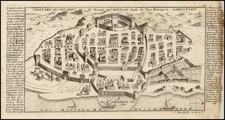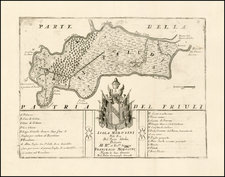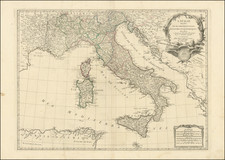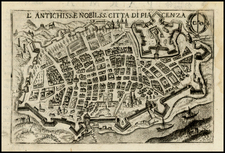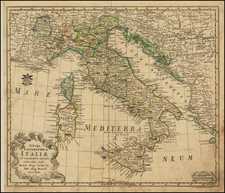The First Attempt At A Modern Map of the Duchy of Milan - General Nicholas Charles Oudinot's Copy
Fine example of Giovanni Ramis's beautiful engraved wall map of the Duchy of Milan, with Lakes Como, Maggiore, and Lugano in the north and the Po River as far as Cassalmagiore in the south.
The map's title cartouche is surmounted by the Austrian eagle, and a large allegorical vignette occupies the lower left corner of the map.
The map is of particular interest for its relatively naive depiction of topographical information, at a time when most of the regions around the Duchy of Milan were undertaking sceintific surveys and far more scientifically accurate maps.
Ramis's map was an attempt to satisfy a request by Wenzel Anton, Prince von Kaunitz-Rietberg, (and then State Chancellor) for a precise modern survey of the Duchy of Milan and Lombardy. However, the cost of the surveying was not supported by the central Austrian government, and so it fell to Milan to support it. Ramis's map represents an attempt to retrofit earlier local information into a more modern presentation. Von Kaunitz found the map lacking, a fact which he expressed in writing to Count Firmian, the Governor of Milan. The need for an authoritative fully modern geodetic survey of the region was finally met by De Cesaris, Reggio, and Oriani's large map of 1788-96.
The Duchy of Milan, Austria, and Napoleon
Austria invaded the Duchy of Milan and seized it from the Spanish in 1701, during the War of the Spanish Succession (1701-1714). The Treaty of Baden, which ended the war in 1714, ceded Milan to Austria. The duchy remained in Austrian hands until it was overrun by the French army of Napoleon Bonaparte in 1796. The duchy was ceded by Austria in the Treaty of Campo Formio in 1797 and formed the central part of the new Cisalpine Republic. After the defeat of Napoleon, based on the decisions of the Congress of Vienna on 9 June 1815, the Duchy of Milan was not restored. The Duchy instead became part of the Kingdom of Lombardy-Venetia, a constituent of the Austrian Empire and with the Emperor of Austria as its king. This kingdom ceased to exist when the remaining portion of it was annexed to the Kingdom of Italy in 1866.
General Nicolas Charles Oudinot
A final detail that gives this map particular importance is the identity of its former owner, Nicolas Charles Oudinot, 1st Comte Oudinot, 1st Duc de Reggio (1767 - 1848), and a Marshal of France. A fierce fighter, the man was wounded no less than 34 times during his military career!
The only one of nine siblings to live past childhood, Oudinot joined the army without a noble pedigree, and therefore without a chance of high promotion. That all changed in 1792, with the outbreak of the French Revolution. In that year, Oudinot was elected lieutenant-colonel of the third battalion of the volunteers of the Meuse. After transfer to the regular army and admirable service in Belgium, he was promoted to the rank of general in June 1794 after the Battle of Kaiserslautern.
From Belgium he shifted to the German and Swiss fronts, where he fought as a general of division and chief of staff to Andre Massena. Oudinot stood out at the Battle of Monzambano so much so that Napoleon himself presented him with a sword of honor, now known as the Legion d'Honneur. Napoleon did not forget him after he established his empire; now Emperor Napoleon recognized Oudinot again, this time with a Grand Cross of the Legion of Honor.
During the Napoleonic Wars, Oudinot continued to acquit himself commendably. He was elected a member of the Chamber of Deputies, commanded a company of grenadiers nicknamed for him, and fought in battles from Vienna to Poland. In 1808, he was appointed governor of Erfurt and was made a Count of the French Empire. Finally, in 1809, after the Battle of Wagram, he was named a Marshal of France, France's highest military distinction.
Oudinot continued to serve as an administrator in Holland and on the battlefield in the Russian campaign. After Napoleon's fall, Oudinot joined the Bourbon Restoration and stayed loyal to the King even after Napoleon's return in 1815. For his loyalty and service, he was named a peer of the realm. He served until 1823, when he participated in the French invasion of Spain. Then, he turned again to political and administrative appointments; he died while serving as governor of Les Invalides, at the veterans' hospital in Paris.
Provenance
Purchased at auction in Paris, from Artcuriel, Collections from the Castle of Malicorne Marshal Oudinot's Historical Souvenirs, June 13, 2017 (Lot 156).
Rarity
WorldCat records one copy of the map, at the British Library.









